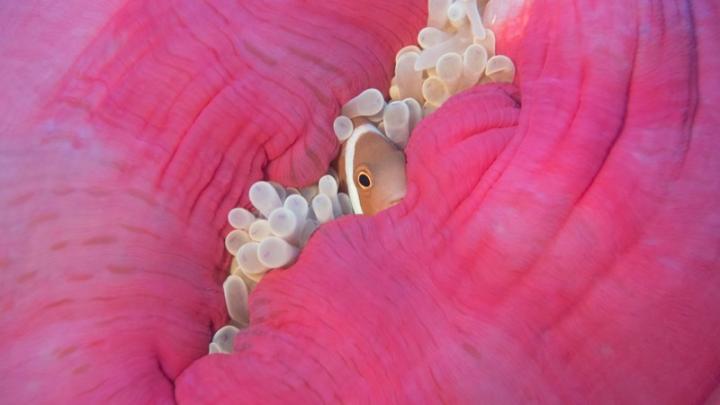UD researchers examine how anemones help fish fend off foes

Credit: Photo by Stefan Andrews
When predators hunt for small reef fish in the ocean, many of those small fish do the same thing: they hide in a nearby anemone.
New research from the University of Delaware, however, shows that larger-bodied fish also associate with anemones. The difference is that the big fish associate with anemones as juveniles, while the smaller bodied species partner with anemones throughout their lives.
This mutualistic relationship, in which individuals from two or more species cooperate, is driven by predation. Predators tend to target smaller fish, who in turn, associate more with the anemones for protection. While the benefit for fish is protection from predators, anemones get access to nutrition and increased aeration by hosting and protecting these small reef fish.
“Being able to understand why this relationship has evolved can tell us more about coral reef ecosystems as a whole,” said Lane Johnston, who graduated with her master’s degree from UD in marine behavioral ecology in 2018 and worked on the study during her time at the University. “Our finding was that predation and trying to avoid predation is really what drives the relationship, and that might help us understand how population dynamics change on a reef or in any ecosystem moving forward.”
The research was recently published in the Ecology Letters scientific journal.
Johnston conducted the study in Moorea, located in French Polynesia, with her advisor, Danielle Dixson, assistant professor in the College of Earth, Ocean and Environment’s School of Marine Science and Policy; William Feeney, now a postdoctoral research fellow at the University of Queensland in Australia who worked as a Fulbright Fellow in Dixson’s lab during the study, and Rohan Brooker, now a research fellow at Deakin University in Australia who was a post-doctoral researcher in Dixson’s lab during the study.
From January through February 2016, the researchers collected anemones and corals as well as threespot dascyllus — a fish they chose to be their case study subject that is an anemone mutualist — on snorkel and scuba dives, in order to conduct a lab study along with a field study in the shallow reef flats at Tema’e Bay.
They selected surge damselfish as a locally abundant and non-anemone associated comparison species to the threespot dascyllus, and sorted the damselfish and the dascyllus into four size categories:
- Recruit — less than 2 centimeters in size;
Juvenile — 2 to 4 centimeters in size;
Small adults — 4 to 6 centimeters in size; and
Large adults — larger than 6 centimeters.
Arceye hawkfish, speckled sandperch and squirrelfish were selected as the predators in the study.
The purpose of these experiments was to see if dascyllus’ body size could explain patterns of anemone associations between individuals under natural conditions, whether smaller fish were more vulnerable to predation by the three predators compared to their larger counterparts and whether associations with anemones provided more protection than coral refuge.
Their field study revealed that recruit and juvenile dascyllus associate almost exclusively with anemones whereas anemone use progressively decreased among the small adult and large adult dascyllus.
They also discovered no preference among the predators with regards to body size with the dascyllus and that if anemones were available, they helped the dascyllus survive predation better than the coral.
“It’s kind of intuitive. If smaller fish can’t be protected from predators, they need to find a habitat that can aid in protecting them when they’re smaller,” said Johnston. “It makes sense [that they’d use anemones], and we just needed to prove it.”
In addition to the field and lab study, collaborators in Australia, France and the UK followed up on the field results to determine the evolutionary history behind anemone use.
Using large datasets from places like fishbase.org, a global fish species database, these researchers found that fish-anemone mutualisms have evolved on at least 55 occasions across 16 fish families over the past 60 million years. Moreover, they also found that larger-bodied species partnered with anemones as juveniles while smaller-bodied species partner with anemones throughout their lives.
Johnston said that it was interesting to discover that many species of fish associate with anemones, as they have been linked in the past to only a handful of fish species, such as the titular hero in the movie, Finding Nemo.
###
Media Contact
Peter Kerwin
[email protected]
302-831-8749
Original Source
https:/




